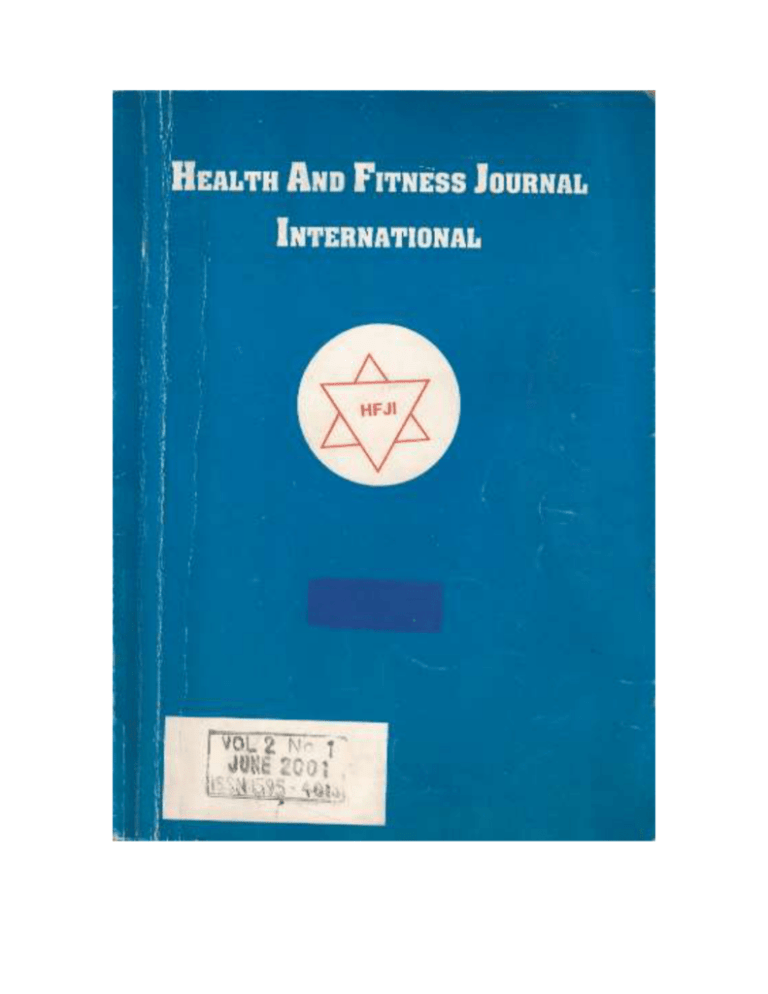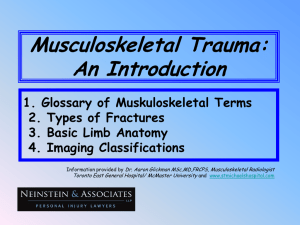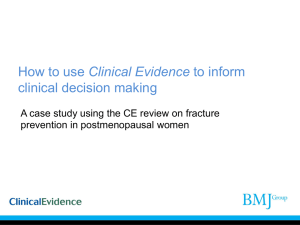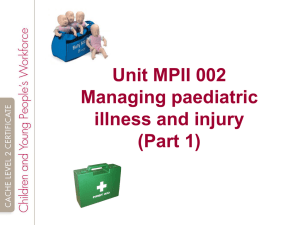Fractures: pattern of incidence/causative factors and treatment in
advertisement

HEALTH AND FITNESS JOURNAL INTERNATIONAL (HFJI) PUBLISHED BY HEALTH AND FITNESS ASSOCIATION OF NIGERIA Vol. 4 No 1 & 2 Dec 2003 ISSN – 1595 – 4013 2 TABLE OF CONTENTS CONTENTS PAGE HARMFUL TRADITIONAL PRACTICES AFFECTING WOMEN’S HEALTH IN ENUGU STATE: A GENDER-BASED RESPONSE URSULA C. EGEJUR U NNAB UEZE 5 PSYCHODYNAMICS OF GROUP STRESS AND TEAM PERFORMANCE O. G. OSHODIN & G. O. EGOR: 17 FRACTURES: PATTERN OF INCIDENCE! CAUSATIVE FACTORS AND TREATMENT AT OLIVES HOSPITAL, IBADAN, NIGERIA OLAITAN, O. ‘LANRE 28 ANAEROBIC PERFORMANCE OF LOWER AND UPPER LIMBS IN MALE AND FEMALE ADOLESCENTS F. R. HARUNA 37 THE RELATIONSHIP BETWEEN DRUG EDUCATION TEACHING AND KNOWLEDGE OF EFFECT OF DRUG ON INDIVIDUAL AMONG PRIMARY SCHOOL PUPILS ONIVANGI, SHUAIB. O. & OWOJAIYE, SUNDA ONI 3 45 NUTRITION AND BODY WEIGHT CONTROL AMONG PUBLIC SERVANTS IN EKITI STATE, NIGERIA DR. J.A.ADEGUN 51 THE PREVALENCE OF LOW BACK PAIN IN SCHOOL CHILDREN IN ILORIN METROPOLIS ADESINA M. O. & TALABI. A.E. 58 PRIMARY HEALTH CARE AND HEALTH EDUCATION ONIFADE, O.A. 64 IMPLICATION OF RECREATION CENTRE MANAGEMENT ON HEALTH AND FITNESS HANNAH .I. MUSA & ECHERUO M. C. 76 KINESIOLOGICAL PRINCIPLES AND SPORTS PERFORMANCES: A REVIEW BAKINDE S.T. 84 ATTITUDES OF ADULTS TOWARDS ENVIRONMENTAL HEALTH PROBLEMS: A CASE STUDY OF UMUEKWE COMMUNITY IN NIGERIA O. G. OSHODIN & GODWIN NNEJI OKERE 91 MOTIVATIONAL INTENT FOR RECREATIONAL PHYSICAL FITNESS PROGRAMME BY OFFICERS AND MEN OF NIGERIA IMMIGRATION SERVICE IN NIGERIA ECHERUOM C. 104 4 PERCEPTION OF HEALTH PERSONNEL ON THE FACTORS OF INFESTATION OF CHILDHOOD DISEASE AMONG SCHOOL CHILDREN IN ILORIN LOCAL GOVERNMENT AREA OF KWARA STATE. ONIVANGI, S. O. 111 COMPARATIVE STUDY OF FITNESS LEVEL OF NORMAL AND DEAF PUPILS IN SCHOOLS: A CASE STUDY OF SPECIAL SCHOOL IN AKWA IBOM STATE, NIGERIA. JONA I. N. 120 MANIFESTATION OF SEXUAL DYSFUNCTION BY LITERATE MARRIED WOMEN: IMPLICATION FOR MARITAL COUNSELLING ABDULRAZA Q OLA YINKA ONIYE 129 5 Advisory committee: Professor L.Emiola - University of Ilorin Professor O.Oshodin - University of Benin Professor S. Jimoh - University of Ilorin Dr. S. Umoh - Professor A Adewoye - Dr. Danladi Musa - Professor A. L. Toriola - 6 University of Ilorin University of Ilorin Bayero University, Kano University of the North, South Africa. EDITORIAL This edition (6th) is dedicated to great men and women whose thoughts have contributed to the realization of the importance of Health and Fitness in our lives. These great thoughts: • To keep the body in good health is a duty... otherwise we shall not be able to keep our minds strong and clear — Buddha • The ideal and goals of life which have always made mankind feel fulfilled rest on good health - Anonymous • Love is the beauty of the soul... Health is its strength — Anonymous • Good health is a foundation for the quality day and life- George Wilber. • Healthy people provide a strong foundation for economic development.World Economic Forum 2002. - have brought home to us the truth that poor health and fitness will certainly detract from our ability to maximize our potentials in this new era. 7 FRACTURES: PATTERN OF INCIDENCE! CAUSATIVE FACTORS AND TREATMENT AT OLIVES HOSPITAL, IBADAN, NIGERIA OLAITAN, O. ‘LANRE DEPARTMENT OF PHYSICAL AND HEALTH EDUCATION, UNWERSJTYOFJLORIN, KWARA STATE, NIGERIA. ABSTRACT In this study, the pattern of incidence of fracture was studied, so also the possible ways of preventing the complications of fracture were highlighted. Fracture, which is known as any breaking in the continuity of a bone, was the main focus and the causative factors and treatment measures at the Olives Hospital and Maternity, Ibadan, Nigeria were highlighted. The study comprised of 28 cases of fracture reported at the Olives Hospital and Maternity, Ibadan, between July 2001-July 2002. The most threatening causes of fracture were found to be road traffic accident (RTA.), the next commonest place of occurrence was in the school. Immobilization was found to be very effective in preventing the complications of fracture, good positioning on the fracture bed and mild exercise after the cast removal was found to have enhanced very speedy recovery to return the victim to former limb function. 89.3% of all the cases were fully recovered without any complication while only 10.7% where treatment still continued have a mild contracture. Various preventive measures such as, public lectures as well as establishment of fracture management centers in Nigeria were recommended. INTRODUCTION The bones of the body are important, for they provide strength and stability for all other organs. They also carry other important functions. According to Anderson (1996), our bones provide a vast storehouse for minerals, fats, and proteins, all of which are constantly being utilized to meet the needs of the body. 8 There are about 206 bones in the human body. The number varies according to person’s age with children having a few more. As a person grows older, some of the lower bones in the spine fuse together (Waimsiery & Murphy, 1982). The stability of the body depends on the bones. When the bone is cracked or broken, the condition is referred to as a “fracture”. Appley & Solomon (1993), opined that, fractures are the most common types of injury to bone. Gatterall (1992) believed that many people suffered serious deformities because of poor management and mal-handing of fracture. Infact, some are unfortunate not to receive treatment at all for years and after some time, deformities that might have easily, been prevented by proper treatment did occur. There is no reason for neglecting a broken bone as much can be done by first aiders and doctors especially now that orthopedists are now available almost everywhere. Every fracture should be given appropriate treatment right from the very first. The first aid given to the fractured bone predetermined the end result (Fishbein, 1963). Two major classes of fractures, ‘simple’ and ‘compound’ have been recognized (Anderson, 1996). In simple fracture, there is usually no break in the skin while in a compound fracture, the skin may be torn, and the broken ends of the bones may be seen piercing out through the skin. Of these two, the compound fracture is far more serious because of the danger of infection, which may penetrate into the body through the opening. Careless handling of fracture may sometimes turn a simple fracture into a compound fracture. Therefore, 9 proper handing is more important so that deformity is reduced and possibility of infection is rendered impossible. However, simple fractures must not be considered lightly, although, some broken ends of the bone may not be sticking though the skin, but they may cut through some of the nearby nerves and blood vessels. Furthermore, if in fracture, the broken bone ends lacerate some of the internal organs, like the lungs or bladder; it is therefore referred to as “complicated” fracture (Catterall 1992). Therefore, all fractures must be handled with care. The causes of fractures as highlighted by Monk (1982), are by direct violence or indirect violence. The most common causes of fractures are by direct violence. This includes severe contusion or impact, such as a blow or fall. An indirect violence type of fracture is by falling on the outstretched arm or elbow this may transmit the force to the clavicle to break in which the arm or elbow may not necessarily fracture. So also powerful muscular contraction may cause fracture. This can occur when there is no muscle synchronization (Monk, 1982). There are many signs and symptoms of fracture. In most case of fracture, the victim will tell that he heard or felt the bone snap. This snap maybe inform of a crepitus or key sound. So also, there will be pain and tenderness in the area, followed by swelling. The skin may become discoloured due to the presence of bleeding beneath the tissues. The broken ends of the bone may sometimes be felt over lapping. The injured part may appear to be a little shorter than the uninjured one (Cyriax, 1983). In case of severe fracture, the victim may 10 complain of weakness or sometimes, faintness may occur. This is known as “shock”. This must be immediately treated before any further thought is given to the broken bone (Monk, 1988). Diagnosis of fracture according to Apley & Solomon (1983), is mainly though x-ray. Other methods of diagnoses are by looking for the signs and symptoms such as, deformity of the area, direct or indirect tenderness, loss of limb function, crepitus bony deviation, swelling of the area, echymosis, discolouration, pains, false joint, etc. According to Monk (1988), all fractures should be handled with care most especially by immobilization through application of splints which may be improvised from many different things such as, coat, pillow, folded blanket, magazine, several newspapers folded together, and similar articles may be very useful as splint. Sticks, branches from trees, umbrellas, walking sticks, car tools (if on the highway), cupboard doors, wide boards, broom handles, all these may serve in any emergency. If in school, rulers are the best types of splits especially for any of the limb fractures. The main thing is hold to the broken fragments steady and interrupts the movement of the site abruptly. The splint is well padded where it touches the skin to provide cushion to the injured part. It may be necessary to sling the injured part if it involves the upper limb i.e. the shoulders upper arms, lower arms, wrists or hands. 11 Complications of Fractures Apely & Solomon (1993), stressed that complications of fracture are very difficult to correct. They include, shock, thromboembolism and infections such as tetanus and gas gangrene. Local complications may involve the bones or the soft tissues in the vicinity of the fracture. The complication involving the fractured bone includes infection, delayed union and non-union, mal-union, growth disturbance and a vascular necrosis. Complication involving the injured soft tissue is vascular injury, compartment syndrome (Volkmann’s Ischhaemia) nerve injury, visceral injury and myositis ossiflcans. While the complications involving join are joint stiffness osteoarthritis and sudeck’s atrophy. METHED0LOGV 28 patients, 20 males and 8 females reported for treatments from various places Ibadan, majority of which were brought by members of Federal Road Safety Crops (FRSC) to Olives Hospital and Maternity Ibadan, Nigeria. Schoolteachers’ and relatives brought the remaining cases to the hospital all between July 2001 and July. 2002 (Fig 1). As each patient reported for treatment, the relevant history of occurrence was taken, and the affected parts of the body were examined by physical examination and followed by X-ray for more precise diagnosis. In order that they may understand the purpose of treatment, the various complications including the possible residual deformities and disabilities were fully explained to them and their relatives. To avoid or prevent the complications 12 of fracture, the cooperation of the patients and their relatives were sought right from the first day of reporting for treatment, so that they can carry out all instructions given to them. All the 28 patients with fractures of legs, arms and collarbone were treated at Olives Hospital and Maternity Ibadan in a 12 months period from July 2001 to July 2002. In all cases, the clinical notes and radiographs (Xray films) were examined. Completed follow-up was available in all the cases. There were 20 males and 8 females with ages ranging from 5 to 35 years (mean 22.1 years) (fig 2). Over half of the patients were between 20 and 34years of age. The causes of injury are as shown. With road traffic accident (RTA) as most prevalence. (Table 1). TYPES OF FRACTURE In the 28 patients, diagnosis was made within the first 24 hours. All the patients had pain, swelling and tenderness in the sites of the fracture. Eleven patients had fracture of one upper leg bone (femur) each, 3 with fractures of both upper leg bones (both femur), 5 with fractures of one lower leg bones (tibia and fibula) each 3 with fracture on one upper arm bone (humerus), 3 with fracture of one lower arm bone (radius and Ulna) and only 3 with the fracture of one collar bone (clavicle) (Table 2.) RESULTS Although the sample size of this sample was rather small, the findings have thrown more light on possible prevention of fracture complications as well 13 as identified some beneficial procedure of hospital workers in the management of fractures. In this study, the most threatening causes of fracture as been found to be Road Traffic Accident (RTA). The second major cause was identified to be fall. (Fig I). The commonest place of occurrence of fracture was identified as, on the highway especially along Thadan —Oyo-Ilorin road, while the second commonest place of occurrence was at school. The age group most commonly involved in fractures was found to be 25-29 years old (Fig 2/Table3). The males (70.4%) were found to be more involved in the incidence of fracture than females (where only 28.6% were involved) (table 3). This study has identified that good positioning while on fracture bed and immobilization of the affected area were found to have enhanced the much speedy recovery that followed. In about 5 cases where mal-alignment were seemingly setting in, the repeat cast after re-alignment that were employed were found to be useful particularly at the acute phase. The other procedures, particularly the intensified programmme of exercise after the union in the bone and cast removal were found very helpful in returning the affected limb to their previous normal functions. In all cases treated 25 (i.e. 89.3%) fully recovered and were fmally discharged without any complications. In only 3 cases (i.e. 10.7%) treatment still continued but in these cases there were no traces of any 4. 14 CONCLUSIONS & RECOMMENDATIONS The most threatening causes of fracture discovered in this study at Olives Hospital and Maternity Ibadan was Road Traffic Accident (RTA). In this study, more incidents of fracture were recorded for the ages are 25-29 years old than other age groups. (Fig 2). This could be based on the fact that young adult between 25-29 years of age are very active and for curiosity, they involved more in energy tasking work especially, driving than the other lower age groups. This age group is also noted for undertaking very risky driving skill from this study, the acquired knowledge of the pattern of the most common causes of fractures provides the basis of campaigns for successful preventive measures. As a first step the drivers need to be educated on road safety education and only be awarded the drivers’ license having passed the prescribed test accordingly. The second step of this preventive measures should involve education of the people generally on how to place things and be careful wherever they are, to avoid falls. In this instance, things should be well placed in the schools and the childrenlpupils should be properly monitored while playing on the swings and other recreational equipment in the school. Moreover, first aid training should be made available for all, irrespective of their professions and first aid boxes should be made available in vehicles especially commercial vehicles, in schools, at home, and in industries. So also, there should be public lectures and demonstrations in all communities and institutions on how to be more safety conscious generally. Such 15 topic like Road Safety Education, School Safety Education, Home Safety Education and Industrial Safety Education Should be included. Finally, fractures management centre/orthopedic units should be established in most of the government hospitals and other medical centres all over the country where comprehensive management of all fracture cases could be undertaken. In addition, all the existing hospitals all over the country should developed and equip their orthopedic units with relevant facilities to help in the prompt management of accidents and fracture cases in our society. TABLE 1: MECHANISM OF INJURY OF FRACTURE OF THE BONE Cause No of cases % Road Traffic Accident (RTA) 17 60.7 Fall 8 28.6 Blow 3 10.7 Total 28 100 TABLE 2: TYPE OF FRACTURE SITES Fracture No of patients Percentage of total patients % 14 (3 bilateral) 50 Tibia/fibula 5 17.9 Humerus 3 10.7 Radius/Ulna 3 10.7 Clavicle 3 10.7 28 100 Femur Total 16 TABLE 3: SEX AND AGE DISTRIBUTION Age in year Male Female Total 5 0.4 - - - - 5-9 3 4 6 21.4 10-14 3 - 3 10.7 15-19 - - - - 20-24 4 - 4 14.3 25-29 5 5 10 35.7 30-34 5 - 5 35.7 Total 20 8 28 100 79.4% 28.6% 100% * % Total TABLE 4: THERAPEUTIC REPONSES Therapeutic responses Male Female Total % Complete recovery without complication 17 8 25 89.9 Still treating with mild bony deviation 3 - 3 10.7 20 8 28 100 71% 28% 100% * (contracture) Total % Total 17 25 20 15 10 5 0 Highw ay (Road) Fig. 1: School Home Place of occurrence 12 10 8 6 4 2 0 5-9yrs 10-14yrs 15-19yrs 25-29yrs 30-34yrs 39-34yrs Fig 2: Age of the patients 70 60 50 40 30 20 10 0 RTA FALL 18 OTHERS Acknowledgement The author of this paper is profoundly grateful to the members of Federal Road Safety Corps (FRSC) and Nigerian Police Force. At the same time, I am greatly indebted to the Medical Dk€4r and the entire staff of Olive Hospital Maternity, Ibadan, Nigeria. 19 REFERENCES Anderson, C.R (1996), Modern ways to health. Vol. 1 & 2. (Revised.Edition), Teenessee: Southern Publishing Association Apley, A.G & Solomon, (1993), Concise System of orthopaedics and fractures. Cambridge: Butterworth Heinemann Ltd. Catterall, A. (1992), Recent advances in orthopeadics. Edinburgy: Longman Group UK, Ltd Cyriax, J. (1983), Textbook of orthopeadic medicine: treatments by manipulation, message and injection. Vol II (11th Ed.), London: Bailliere Tindall Publishers. Fishbein, M (1963), Illustrated medical and health encyclopedic. Vol. III New York: H.S. Stuttman Co., Publishers. Monk, C.J.E (1988), Orthopaddics for undergraduates (2nd Ed.), Oxford: Oxford University Press. Stone, D.R & Lambert, G.E (1975), Orthopaedic, physicians assistant techniques allied health series. Indianapolis. Howard W. Sams & Co., Inc. Walmsley, R & Murphy, T.R (1975), Jemieson’s illustrations of regional anatomy. Church Linvigston. Hong Kong: Longman Group Ltd. 20







